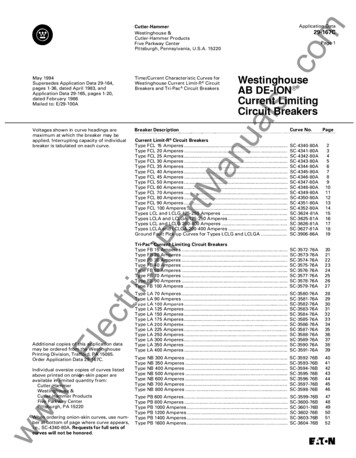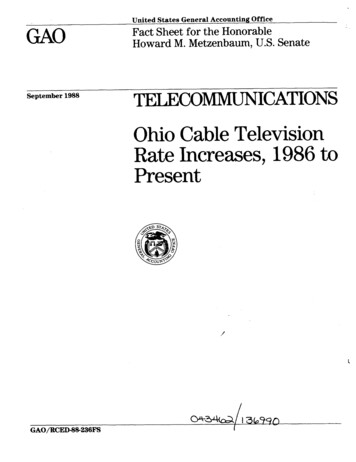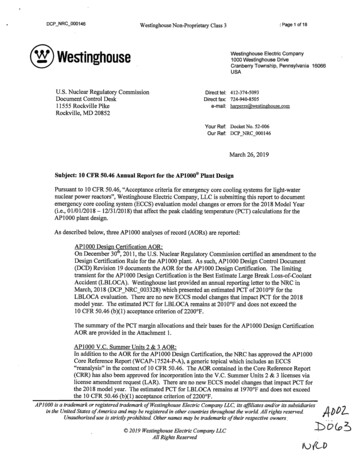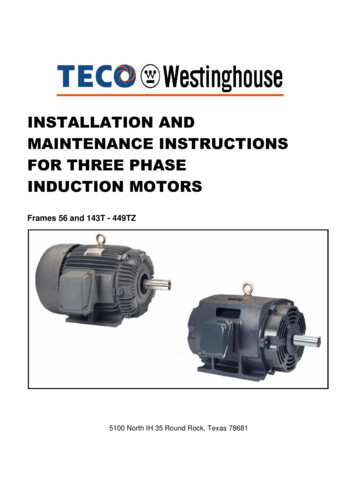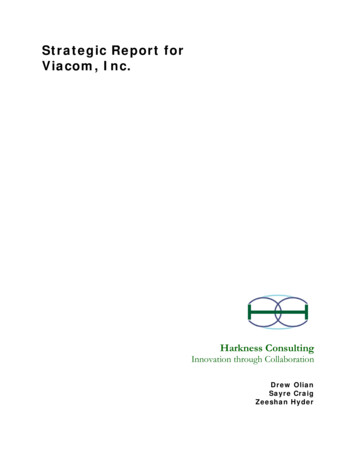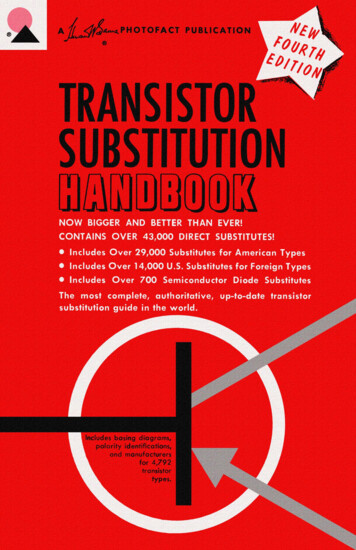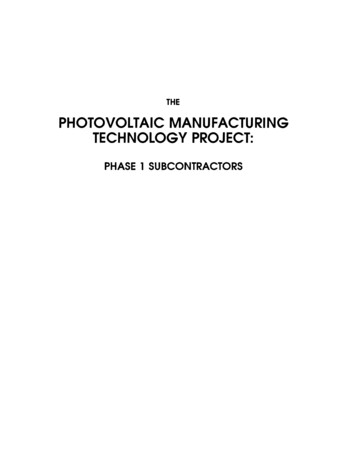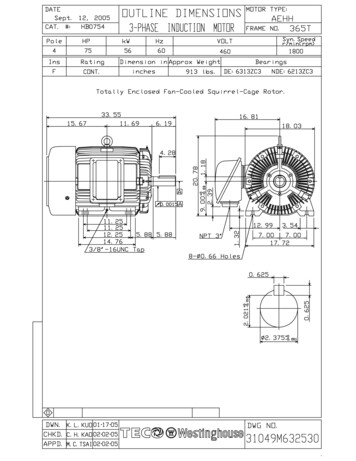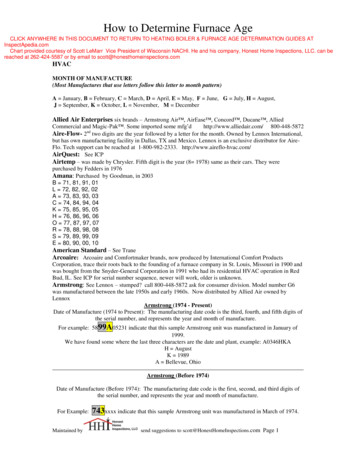
Transcription
Wilson v. AC&S, Inc. et alDoc. 96UNITED STATES DISTRICT COURTFOR THE EASTERN DISTRICT OF VIRGINIANewport News DivisionRORIE N.WILSON,Plaintiff,V.ACTI0NN0.4:14cv91AC&S, INC. etal.Defendants.OPINION AND ORDERThis matter comes before the Court on defendant CBS Corporation's (formerly known asViacom, Inc., and Westinghouse Electric Corporation) ("Westinghouse's") motion for summaryjudgment. Westinghouse filed its motion for summary judgment on September 8, 2015. ECFNo. 47. Plaintiff filed his response in opposition on September 19, 2015. ECF Nos. 63, 64. OnSeptember 23, 2015, Westinghouse filed a rebuttal brief in support of the motion for summaryjudgment. ECF No. 71. On October 9, 2015, the Court held a motions hearing. For the reasonsnoted below, the Court ORDERS that Westinghouse's motion for summary judgment isGRANTED.I. PROCEDURAL HISTORYOn July 3, 2002, plaintiff filed this action in the Circuit Court for the City of NewportNews ("circuit court"). ECF No. 1 at 2. On July 18, 2014, Westinghouse filed a notice ofremoval to remove the case to this Court. ECF No. 1. On August 16, 2014, plaintiff filed amotion to remand (ECF No. 17) that was subsequently denied in an order by District JudgeArenda L. Wright Allen on March 17, 2015. ECF No. 27.Dockets.Justia.com
Plaintiffs original complaint' named Westinghouse and General Electric ("GE"), as wellas 20 additional defendants that have all since been dismissed from the case. After the cause ofaction was removed to this Court, GE filed a motion for summary judgment (ECF No. 51), amotion to dismiss (ECF No. 57), and a motion in limine to exclude the testimony of plaintiffsexperts, R. Leonard Vance, Ph.D., J.D., PE, CIH ("Dr. Vance"), and John C. Maddox, M.D.(ECF No. 83). Plaintiff simply did not respond to GE's motions and informed the Court for thefirst time at the hearing on October 9, 2015 that he would no longer pursue claims against GE.On October 14, 2015, plaintiff filed a notice of voluntary dismissal of GE. ECF No. 91.Accordingly, Westinghouse remains the only defendant left in the case.Additionally, plaintiffs original complaint identified three theories of liability:negligence, breach of implied warranty, and conspiracy. ECF No. 1-1. At the hearing, plaintiffconfirmed that he was no longer pursuing a conspiracy charge against Westinghouse. Thus,negligence and breach of implied warranty remain plaintiffs only two theories of liability.Plaintiffs claims against Westinghouse sparked discovery disputes, which ledWestinghouse to file, on August 28, 2015, a motion to strike plaintiffs objections, compel fulland complete discovery responses, and deem a request for admission admitted. ECF No. 35. OnSeptember 7, 2015, plaintiff responded in opposition to the motion (ECF No. 44) and, onSeptember 10, 2015, Westinghouse filed a reply brief (ECF No. 55). On October 9, 2015, the' Because plaintiff originally filed this action in the circuit court, his complaint for purposes ofthe present action before the Court reads "Motion for Judgment." ECF No. 1-1. Plaintiffs initial complaint named additional defendants: AC&S, Inc.; Amchem Products, Inc.;C.E. Thurston & Sons, Inc.; Combustion Engineering, Inc.; Dana Corporation; The FlintkoteCo.; General Refractories Company; Georgia-Pacific Corporation; Halliburton Energy ServicesCorp.; Honeywell, Inc.; Hopeman Brothers, Inc.; International Minerals & Chemical Corp.;International Paper Corporation; Owens-Illinois, Inc.; Rapid American Corporation; Selby,Battersby & Co.; Uniroyal, Inc.; Waco Insulation, Inc.; Garlock, Inc.; and Metropolitan LifeInsurance Co. ECF No. I-I.
Court heard argument on Westinghouse's motion to compel. In an order issued on October 13,2015, the Court granted Westinghouse's motion to compel full and complete discovery responsesdue to plaintiffs failure to timely respond to discovery or state his objections with specificitypursuant to Rule 26 of the Local Rules of the Eastern District of Virginia ("Local Rules"). ECFNo. 89; E.D. Va. Loc. R. 26. Plaintiff was ordered to supplement his discovery responses byOctober 14, 2015. ECF No. 89.During the pendency of the action, Westinghouse filed multiple motions to exclude. OnSeptember 8, 2015, Westinghouse filed a motion in limine to exclude the report, opinions, andtestimony of Dr. Vance. ECF No. 45. On September 19, 2015, plaintiff filed his response inopposition. ECF No. 61. On September 23, 2015, Westinghouse filed a rebuttal brief in supportof the motion in limine to exclude the report, opinions, and testimony of Dr. Vance. ECF No. 74,On October 9, 2015, the Court held a hearing on this motion and, in an opinion and order,granted Westinghouse's motion in limine to exclude the report, opinions, and testimony of Dr.Vance. Additionally, Westinghouse filed a motion to strike noncompliant expert reports and toexclude the testimony of Richard Alexander, Jr., M.D., Peter Frasca, Ph.D., and John Newton onSeptember 10, 2015 (ECF No. 53), a motion in limine to exclude the testimony of John L. Hoodon September 22, 2015 (ECF No. 67), and a motion to exclude or limit the testimony of Barry 1.Castleman, Sc.D., on September 23, 2015 (ECF No. 75).Plaintiff did not respond toWestinghouse's motion to strike noncompliant expert reports and to exclude testimony ofRichard Alexander, Jr., M.D., Peter Frasca, Ph.D., and John Newton or Westinghouse's motionin limine to exclude the testimony of John L. Hood.On October 2, 2015, Westinghousewithdrew both motions as moot after plaintiff did not include Richard Alexander, Peter Frasca,John Newton, or John L. Hood in his pretrial disclosures as witnesses he intended to call at trial.
ECF No. 79; Fed. R. Civ. P. 26(a)(3). Plaintiff responded to Westinghouse's motion to excludeor limit the testimony of Barry I. Castleman, Sc.D., on October 5, 2015 (ECF No. 85), andWestinghouse filed a rebuttal brief on October 12, 2015 (ECF No. 88).On September 23, 2015, Westinghouse filed a motion to strike plaintiffs claim forpunitive damages. ECF No. 72. Once again, plaintiff did not respond to this motion and,instead, informed the Court for the first time at the hearing on October 9, 2015 that he would nolonger pursue a claim for punitive damages against Westinghouse.Accordingly, the Courtdismissed Westinghouse's motion to strike plaintiffs claim for punitive damages as moot, in anorder dated October 13, 2015. ECF No. 89.On September 8, 2015, Westinghouse filed a motion for summary judgment. ECF No.47. Plaintiff responded in opposition on September 19, 2015 with a memorandum that did notcomply with Local Rule 56, which requires a "specifically captioned section listing all materialfacts as to which it is contended that there exists a genuine issue necessary to be litigated andciting the parts of the record relied on to support the facts alleged to be in dispute." ECF No. 64;E.D. Va. Log. R. 56(B). Plaintiffs response to Westinghouse's motion for summary judgmentmirrors, almost identically, his response to Westinghouse's motion in limine to exclude Dr.Vance.ECF Nos. 63, 64. Both responses referenced and attached two 1960s era technicalmanuals on Westinghouse air circuit breakers and a 2010 naval advisory that notes the possiblepresence of asbestos in certain arc chutes contained within some circuit breakers, neither ofwhich was referenced in Dr. Vance's written expert report.Westinghouse filed a rebuttal brief on September 23, 2015.ECF Nos. 63-6, 63-7, 63-11.ECF No. 71.Westinghouse'smemorandum in support of the motion for summary judgment referenced plaintiffs claimsrelated to Westinghouse micarta, transformers, commutated inverters, turbine generators,
overload relays, and arc chutes, which were all products plaintiff previously claimed hadcontributed to his disease. ECF No. 48 at 15-24; PI. Ans. to Interrog., ECF No. 48-2 at 2-3;Compl. 4, ECF No. 1-1. Plaintiffs response to the summary judgment motion, however, onlyreferenced Westinghouse circuit breakers containing arc chutes. ECF No. 64. At the hearing onOctober 9, 2015, the Court asked plaintiff to clarify which Westinghouse products remained indispute. At that time, plaintiff first advised the Court that he was no longer pursuing claimsagainst Westinghouse for asbestos exposure associated with Westinghouse micarta, transformers,commutated inverters, turbine generators, or overload relays. Westinghouse arc chutes remainthe only product left in dispute. Accordingly, the Court will address the motion for summaryjudgment as it relates to Westinghouse arc chutes.11. STANDARD OF REVIEWA. Summaty JudgmentUnder Rule 56 of the Federal Rules of Civil Procedure, summary judgment is proper if"the pleadings, depositions, answers to interrogatories, and admissions on file, together with theaffidavits, if any, show that there is no genuine issue as to any material fact and that the movingparty is entitled to judgment as a matter of law." Fed. R. Civ. P. 56(c). For the evidence topresent a "genuine" issue of material fact, it must be "such that a reasonable jury could return averdict for the non-moving party." Anderson v. Liberty Lobby, Inc., All U.S. 242, 248 (1986).The party "seeking summary judgment always bears the initial responsibility of informing the[court] of the basis for its motion, and identifying those portions of the pleadings, depositions,answers to interrogatories, and admissions on file, together with the affidavits, if any, which itbelieves demonstrate the absence of a genuine issue of material fact." Celotex Corp. v. Catrett,All U.S. 317, 323 (1986) (quotations omitted).Subsequently, the burden shifts to the
nonmoving party to present specific facts demonstrating that a genuine issue of material factexists for trial. See Matsushita Elec. Indus. Co. v. Zenith Radio Corp., 475 U.S. 574, 586-87(1986) ("When the moving party has carried its burden under Rule 56(c), its opponent must domore than simply show that there is some metaphysical doubt as to the material facts.") Whendeciding a motion for summary judgment, the Court must view the facts, and inferences to bedrawn from the facts, in the light most favorable to the non-moving party. Anderson, All U.S. at255.B. Asbestos-Related Products LiabilityThe parties have not agreed to whether federal maritime law or Virginia law applies toplaintiffs underlying products liability claim. Plaintiffs complaint asserts that the case arises"under the laws of Virginia as well as under the general admiralty and maritime laws of theUnited States." EOF No. 1-1 at 6. In turn, Westinghouse's memorandum filed in support of itsmotion for summary judgment analyzes plaintiffs claim under the standard for asbestos-relatedproducts liability claims brought under maritime law.ECF No. 48.Westinghouse confirmed its belief that maritime law applies.At the hearing,When asked at the hearing,however, plaintiff would not agree that maritime law definitively applies and suggested thatVirginia law may apply instead.The Grubart standard lays out a two-part test for the application of maritime law.Grubart v. Great Lakes Dredge & Dock Co., 513 U.S. 527, 538-40 (1997). First, the "locationtest" in a toxic tort case requires the Court to consider whether the alleged exposure to the toxicsubstance occurred onboard a naval vessel on the navigable waters. Delatte v. A.W. ChestertonCo., 2011 U.S. Dist. LEXIS 121788, at *5-6 (E.D. Pa. Feb. 25, 2011).Secondly, the"connection test" requires that the incident have the "potential to disrupt maritime commerce"6
and "the general character of the activity giving rise to the incident" must show a "substantialrelationship to maritime activity." Id. at *6 {citing Grubart, 513 U.S. at 538-39). The filingspertaining to the motion for summary judgment do not contain sufficient information to enablethe Court to apply the Grubart test to the facts of this case.It is unnecessary to resolve this issue, however, because the standards are fiindamentallysimilar under both maritime and Virginia law. In a products liability case under maritime law,the plaintiff must show that "(1) he was exposed to the defendant's product, and (2) the productwas a substantial factor in causing the injury he suffered." Lindstrom v. A-C Product LiabilityTrust, 424 F.3d 488, 492 (6th Cir. 2005). If plaintiff can show "substantial exposure for asubstantial period of time," this supports a finding that the product substantially causedplaintiffs injury. Id. However, a mere showing that defendant's product existed at plaintiffsworkplace remains insufficient to prove that the product was a substantial factor in causingplaintiffs injury. Id. Plaintiff must show a "high enough level of exposure that an inference thatthe asbestos was a substantial factor in the injury is more than conjectural."Harbour v.Armstrong World Indus., Inc., 932 F.2d 968 (6th Cir. 1991). Under Virginia law, plaintiff mustshow "it is more likely than not" that plaintiffs alleged exposure to asbestos from defendant'sproduct "occurred prior to the development" of his illness and "was sufficient to cause" hisillness. Ford Motor Co. v. Boomer, 285 Va. 141, 159, 736 S.E.2d 724, 733 (Va. 2013). Undereither standard, plaintiff faces the same set of hurdles and, accordingly, the outcome of his casedepends on whether he can establish causation by showing that Westinghouse breached a dutythat caused his injuries. See also Lohrmann v. Pittsburgh Corning Corp., 782 F.2d 1156, 1162-63 (4th Cir. 1986)(noting that, under Maryland state law, a plaintiff in a products liability asbestos case must show"evidence of exposure to a specific product on a regular basis over some extended period of timein proximity to where the plaintiff actually worked").
III. UNDISPUTED FACTSIn 2002, plaintiff filed the present case in circuit court. ECF No. 1-1. From 1963-2001,plaintiff was employed by the United States Navy at Norfolk Naval Shipyard as a shipfitter,electrician, draftsman, and engineer. ECF No. 1-1. Plaintiffs complaint stated that he had beendiagnosed with asbestosis on March 15, 2001, a disease caused by asbestos-containing insulationproducts he encountered at Norfolk Naval Shipyard. ECF No. 1-1. When the case was removedto this Court, plaintiff produced medical records indicating that he had since been diagnosed withmesothelioma, a form of cancer. ECF No. 62-13.Plaintiffs remaining claims stem from his work as a nuclear engineer and electricalengineer from approximately 1971 through 1979, during which he encountered Westinghousecircuit breakers containing arc chutes. PI. Dep. vol. 2, 470:23-471:5, Sept. 17, 2014. Eachcircuit breaker, designed to protect the circuit that supplied electricity to other pieces ofequipment on the ship, contained three arc chutes. PI. Dep. vol. 1, 121:15, Nov. 14, 2014; PLDep. vol. 2, 271:21-272:4, Sept. 17, 2014. The arc chutes associated with the circuit breakerwere designed to catch an electric arc or "fireball" generated by the opening and closing of acircuit. PI. Dep. vol. 1, 128:14-19, Nov. 14, 2014. The arc chutes dissipated the heat and energyaccompanying the fireball moving up the chute so that it did not damage the breaker assembly.PL Dep. vol. 1, 128:21-25, Nov. 14, 2014. Each arc chute was encapsulated in a hard, moldedresin matrix. Vance Dep. 214:17-22.Plaintiff wrote operating procedures and searched for hairline cracks to assistshopworkers tasked with inspecting, testing, and replacing circuit breakers.161:15-162:13, Aug. 21, 2014.PL Dep. vol. 1,Sometimes, plaintiff would hold the arc chutes to look forcracks, blowing and brushing off dust in the process. PL Dep. vol. 1, 162:19-22, Aug. 21, 2014.8
While working as a nuclear engineer, plaintiff checked circuit breakers to ensure properfunctioning. PL Dep. vol. 1, 130:13-15, Nov. 14, 2014. If the arc chute component of a circuitbreaker needed replacement, plaintiff would typically order one. PI. Dep. vol. 1, 133:2-7, Nov.14, 2014. In an emergency situation (that is, if the ship needed to sail immediately), the arcchute would be repaired, but plaintiff did not recall ever personally repairing an arc chute in anemergency situation. PI. Dep. vol. 2, 346:23-347:4, Dec. 22, 2014. Approximately, one week amonth, plaintiff worked on circuit breakers.PI. Dep. vol. 2, 474:23-475:3, Sept. 17, 2014.During this time, shop workers blew the arc chutes with compressed air and dust blew "all over,"including on the arc chutes and frame. PI. Dep. vol. 2, 475:21, Sept. 17, 2014. Plaintiff alsodescribed taking arc chutes back to the shop to work on them at "every availability" between1971 and 1978. PI. Dep. vol. 2,477:22-25, Sept. 17, 2014.IV, ANALYSISAfter Westinghouse filed a motion for summary judgment, plaintiff did not follow therequirements of Local Rule 56, which requires that a brief in response to a motion for summaryjudgment include "a specifically captioned section listing all material facts as to which it iscontended that there exists a genuine issue necessary to be litigated and citing the parts of therecord relied on to support the facts alleged to be in dispute." E.D. Va. Loc. R. 56(B). Not onlydid plaintiff not include a specifically captioned section listing all material facts in dispute, but,as noted by Westinghouse in its rebuttal brief, plaintiff does not even use the words "genuineissue" or "material fact" in his response.ECF Nos. 63, 71 at 4.Notwithstanding theshortcomings associated with plaintiffs response, at the October 9, 2015 hearing, the Courtspecifically gave plaintiff the opportunity to make an additional filing to bring any additionalfacts to the court's attention. See Fed. R. Civ. P. 56(e)(1). On October 13, 2015, plaintiff filed
"supplemental submissions" for the Court's consideration, which included excerpts fromplaintiffs deposition, a Westinghouse technical manual, and a military specification describingcircuit breakers, yet still did not include a statement of disputed facts. EOF No. 90. Nonetheless,the Court considered these supplemental materials.Local Rule 56 specifies that, "[i]n determining a motion for summary judgment, theCourt may assume that facts identified by the moving party in its listing of material facts areadmitted, unless such a fact is controverted in the statement of genuine issues filed in oppositionto the motion." E.D. Va. Loc. R. 56(C); see also Deavers v. Vasquez, 57 F. Supp. 3d 599, 601(E.D. Va. 2014) ("Under the Local Rules, the Court may accept those facts not disputed to beadmitted."). Because the Court must view the facts in the light most favorable to plaintiff, theCourt has examined plaintiffs brief and exhibits to identity any evidence that creates a genuineissue of material fact. For the reasons discussed below, the Court FINDS that, while a genuineissue of material fact exists regarding whether the Westinghouse arc chutes to which plaintiffwas exposed contained asbestos, no genuine issue of material fact exists regarding whetherWestinghouse arc chutes released asbestos fibers that were a substantial factor in causingplaintiffs injury under maritime law or were more likely than not sufficient to cause his injuryunder Virginia law.A. A genuine issue of material facts exists regarding whether the Westinghouse arcchutes to which plaintiff was exposed contained asbestos.At times, plaintiff has expressed less than complete confidence that the Westinghouse arcchutes he encountered contained asbestos. At the motions hearing, plaintiffs counsel stated thatall the evidence combined "suggests that it is very likely that [Westinghouse arc chutes]contained asbestos." Nonetheless, by viewing, in a light most favorable to the plaintiff, evidenceof plaintiff s own knowledge and testimony, two 1960s era technical manuals on Westinghouse10
air circuit breakers, and a 2010 naval advisory that notes the possible presence of asbestos insome kinds of arc chutes, the Court FINDS that a genuine issue of material fact exists regardingwhether plaintiff encountered asbestos-containing Westinghouse arc chutes.Plaintiff testified that the Westinghouse arc chutes he encountered appeared to containasbestos. When questioned about the arc chutes, plaintiff testified that, "[t]hey were made out of- it looked like to me asbestos." PI. Dep. vol. 1,132:7-8, Nov. 14,2014. When asked what partsof the arc chute contained asbestos, plaintiff replied that he thought "the chute itself containedasbestos." PI. Dep. vol. 2, 476:14-18, Sept. 17, 2014. Plaintiff confirmed that he "didn't go tothe chemistry lab and check [the arc chute] out at the time, but it did look like [asbestos] to me"because the arc chute was gray, fibrous, and used in a high-temperature application. PI. Dep.vol. 2, 274:17-275:11, Sept. 17, 2014. Although he received no training on how to identifyasbestos-containing materials, plaintiffs degree in electrical engineering, as well as his workhistory as a nuclear engineer and electrical engineer, support his testimony and help create agenuine issue of material fact about whether the Westinghouse arc chutes he encounteredcontained asbestos. PI. Dep. vol. 2, 221:17-222:3, Dec. 22, 2014; ECF No. 46-3 at 2.This conclusion is also supported by the Westinghouse technical manuals and the navaladvisory provided to the Court in plaintiffs opposition to the summary judgment motion.Although a significant and singular problem with plaintiffs case is his failure to identify theactual product he encountered in the 1970s (that is, the specific kind of Westinghouse circuitbreakers containing the arc chutes in question), the two, 1960s era Westinghouse technicalmanuals and the 2010 naval advisory suggest generally that the Westinghouse circuit breakersdiscussed in those documents actually do or may, respectively, contain arc chutes containingasbestos. ECF Nos. 62-6 at 9, 62-7 at 14 (describing arc chutes containing "metal and asbestos11
plates"); ECF No. 62-11 at 3-4 (noting "[t]he following ACB circuit breakers listed bymanufacturer may contain asbestos arc chutes . . . Westinghouse:All DBN types").Suchevidence, when coupled with plaintiffs deposition testimony, is sufficient to create a genuinedispute of material fact concerning whether plaintiff encountered asbestos-containing arc chutes.B. No genuine issue of material fact exists regarding whether plaintiffs exposure toWestinghouse arc chutes was a substantial factor in causing plaintiffs injury undermaritime law or more likely than not was sufficient to cause plaintiffs injury underVirginia law.This leaves for consideration whether a dispute of material fact exists about whetherWestinghouse arc chutes released asbestos fibers that were a substantial factor in causingplaintiffs injury under maritime law or whether such exposure was more likely than notsufficient to cause such injury under Virginia law. To establish that such a dispute exists here,plaintiff primarily relies on plaintiffs deposition testimony and the expert report and proposedtestimony of his causation expert. Dr. Vance.Plaintiffs knowledge and testimony do not create a genuine issue of material fact aboutwhether Westinghouse arc chutes released asbestos fibers that caused plaintiffs injury. Becauseplaintiff never tested the alleged asbestos composition of the arc chute, his testimony primarilyrecounts his visual observations.PI. Dep. vol. 2, 274:17-275:11, Sept. 17, 2014.Plaintifftestified that the arc chutes he encountered contained what "looked like" asbestos. PI. Dep. vol.1, 132:7-8, Nov. 14, 2014.However, Dr. Vance testified that there is no way to quantifyasbestos in dust solely by visible inspection.Vance Dep. 24:7-20, 233:3-6.Plaintiff alsotestified that he saw visible dust "on the arc chute and on the frame and everywhere." PI. Dep.vol. 2, 475:22-23, Sept. 17, 2014. According to plaintiff, this dust became airborne when the arcchutes were blown with compressed air. PI. Dep. vol. 2, 475:5-23, Sept. 17, 2014. Plaintiff,however, has not advanced any particular knowledge or facts about how much of the dust he12
encountered allegedly contained asbestos. On the other hand, Westinghouse submitted anaffidavit by retired Westinghouse engineer, Raymond McMullen, which notes that the air circuitbreakers plaintiff described were contained in metal cabinets "through which ambient air anddust from the surrounding environment can pass freely from the outside to the inside of thecabinet." ECF 46-10 at 2. Thus, the composition of the dust plaintiff observed is uncertain.Moreover, plaintiffs own knowledge and testimony fail to create genuine issues of material factconcerning the extent of asbestos content in Westinghouse arc chutes, whether the arc chutes heencountered released asbestos fibers, or what concentration of asbestos fibers were released, ifany. Accordingly, plaintiffs testimony creates no genuine dispute of material fact about whetherthe Westinghouse arc chutes released airborne asbestos fibers at levels significant enough toconstitute a substantial factor in causing plaintiffs injury or at levels which were more likelythan not sufficient to cause plaintiffs injury.To attempt to address this gap in proof, plaintiff intended to call Dr. Vance to establishthe threshold limit value that signifies an unacceptable level of airborne asbestos and show thatplaintiff encountered an unacceptable level of airborne asbestos through exposure toWestinghouse arc chutes. In his report. Dr. Vance identifies the accepted threshold limit valueduring the time plaintiff was working as "5 million particles per cubic foot or 12 [fibers per cubiccentimeter]." ECF No. 62-1 at 8. He then concludes that the presence of visible dust indicatesthat plaintiff was exposed to asbestos fibers from Westinghouse arc chutes at levels greater thanthis accepted threshold limit value. ECF No. 62-1 at 8. In two identified opinions at the end ofhis report. Dr. Vance states that "defendants failed to provide appropriate warnings about thehazards of asbestos to [plaintiff]" and "the defendants' actions in these respects fell beneath areasonable standard of care."In a 21 page opinion and order, the Court discussed why Dr.13
Vance's report, opinions, and proposed testimony fail to satisfy the standards identified byDaubert and Federal Rule of Evidence 702. Daubert, 509 U.S. 579 (1993); Fed. R. Evid. 702.In sum, the Court found the reasoning and methodology Dr. Vance used to conclude that plaintiffencountered an unacceptable level of airborne asbestos was unreliable. The Court also found Dr.Vance's report, opinions, and proposed expert testimony were not relevant because they were not"sufficiently tied to the facts of the case" and incapable of aiding "the jury in resolving a factualdispute." Daubert 509 U.S. at 591.Plaintiff acknowledged Dr. Vance's essential role in his case when he submitted virtuallyidentical responses to Westinghouse's motion to exclude Dr. Vance and Westinghouse's motionfor summary judgment. He also acknowledged Dr. Vance's role in his case at the motionshearing. The Court asked plaintiff about other evidence, documents, facts or testimony that hewould rely on to prove that Westinghouse arc chutes caused his injury in the event that the Courtgranted Westinghouse's motion to exclude Dr. Vance. Plaintiffs counsel responded that "Dr.Vance's testimony would be critical to the case" and answered affirmatively when the Courtclarified whether his answer signified an inability to provide other sources proving causation.Notwithstanding the concessions by plaintiffs counsel, the Court gave plaintiff the opportunityto supplement its opposition to the summary judgment motion to attempt to remedy plaintiffsfailure to comply with the Local Rules and bring any such facts to the Court's attention. Afterplaintiff filed "supplemental submissions" for the Court's consideration, ECF No. 90, the Courtconducted a searching inquiry through all evidence submitted for any facts supporting plaintiffstheory of causation. However, the Court has found no facts that give rise to a genuine dispute ofmaterial fact regarding whether Westinghouse arc chutes caused plaintiffs injury.14
V. CONCLUSIONAccordingly, the Court FINDS the evidence is not "such that a reasonable jury couldreturn a verdict for the non-moving party." Anderson, All U.S. at 248. Although a genuineissue of material fact exists regarding whether the Westinghouse arc chutes plaintiff workedaround contained asbestos, no genuine issue of material fact exists regarding whether such arcchutes emitted airborne asbestos fibers to which plaintiff was exposed and which were asubstantial factor in causing plaintiffs injury or more likely than not were sufficient to causeplaintiffs injury. Accordingly, the Court FINDS that summaryjudgment is proper.VI. ORDERFor the reasons discussed above, the Court hereby ORDERS that Westinghouse's motionfor summary judgment, ECF No. 47, is GRANTED.Moreover, the Court ORDERS thatWestinghouse's motion to exclude or limit the testimony of Dr. Castleman, ECF No. 75, isDENIED as MOOT.The Clerk of Court shall mail a copy of this Opinion and Order to all counsel of record.Robert J.KraskUnited StatesMa tetrate JudgeRobert J. KraskUnited States Magistrate JudgeNorfolk, VirginiaNovember / f, 201515
Plaintiffs original complaint' named Westinghouse and General Electric ("GE"), as well as 20 additional defendants that have all since been dismissed from the case.
